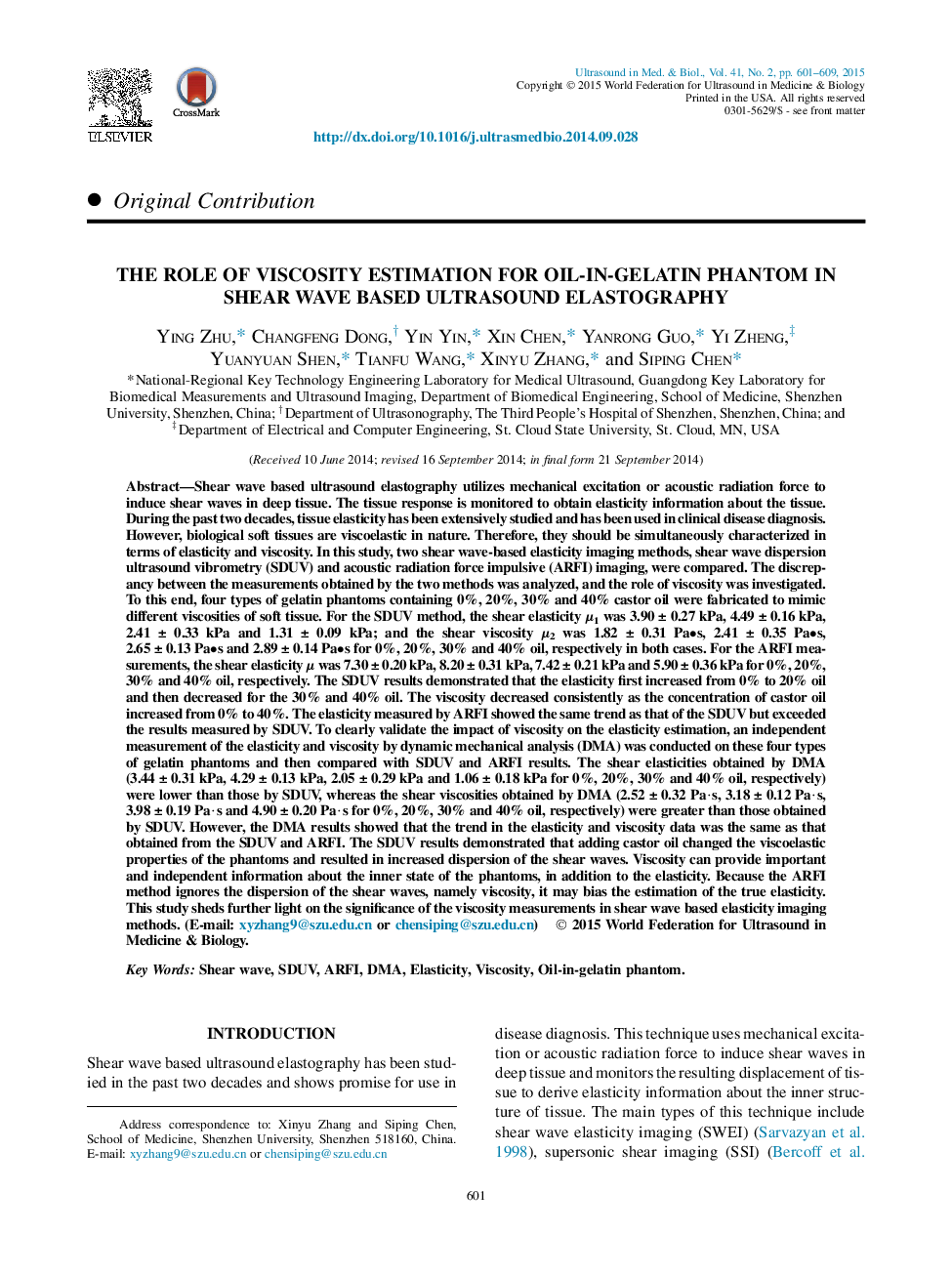| کد مقاله | کد نشریه | سال انتشار | مقاله انگلیسی | نسخه تمام متن |
|---|---|---|---|---|
| 10691414 | 1019597 | 2015 | 9 صفحه PDF | دانلود رایگان |
عنوان انگلیسی مقاله ISI
The Role of Viscosity Estimation for Oil-in-gelatin Phantom in Shear Wave Based Ultrasound Elastography
ترجمه فارسی عنوان
نقش برآورد ویسکوزیته برای فانتوم نفت در ژلاتین در الستوگرافی اولتراسوند بر اساس موج برشی
دانلود مقاله + سفارش ترجمه
دانلود مقاله ISI انگلیسی
رایگان برای ایرانیان
کلمات کلیدی
موضوعات مرتبط
مهندسی و علوم پایه
فیزیک و نجوم
آکوستیک و فرا صوت
چکیده انگلیسی
Shear wave based ultrasound elastography utilizes mechanical excitation or acoustic radiation force to induce shear waves in deep tissue. The tissue response is monitored to obtain elasticity information about the tissue. During the past two decades, tissue elasticity has been extensively studied and has been used in clinical disease diagnosis. However, biological soft tissues are viscoelastic in nature. Therefore, they should be simultaneously characterized in terms of elasticity and viscosity. In this study, two shear wave-based elasticity imaging methods, shear wave dispersion ultrasound vibrometry (SDUV) and acoustic radiation force impulsive (ARFI) imaging, were compared. The discrepancy between the measurements obtained by the two methods was analyzed, and the role of viscosity was investigated. To this end, four types of gelatin phantoms containing 0%, 20%, 30% and 40% castor oil were fabricated to mimic different viscosities of soft tissue. For the SDUV method, the shear elasticity μ1 was 3.90 ± 0.27 kPa, 4.49 ± 0.16 kPa, 2.41 ± 0.33 kPa and 1.31 ± 0.09 kPa; and the shear viscosity μ2 was 1.82 ± 0.31 Pa
- s, 2.41 ± 0.35 Pa
- s, 2.65 ± 0.13 Pa
- s and 2.89 ± 0.14 Pa
- s for 0%, 20%, 30% and 40% oil, respectively in both cases. For the ARFI measurements, the shear elasticity μ was 7.30 ± 0.20 kPa, 8.20 ± 0.31 kPa, 7.42 ± 0.21 kPa and 5.90 ± 0.36 kPa for 0%, 20%, 30% and 40% oil, respectively. The SDUV results demonstrated that the elasticity first increased from 0% to 20% oil and then decreased for the 30% and 40% oil. The viscosity decreased consistently as the concentration of castor oil increased from 0% to 40%. The elasticity measured by ARFI showed the same trend as that of the SDUV but exceeded the results measured by SDUV. To clearly validate the impact of viscosity on the elasticity estimation, an independent measurement of the elasticity and viscosity by dynamic mechanical analysis (DMA) was conducted on these four types of gelatin phantoms and then compared with SDUV and ARFI results. The shear elasticities obtained by DMA (3.44 ± 0.31 kPa, 4.29 ± 0.13 kPa, 2.05 ± 0.29 kPa and 1.06 ± 0.18 kPa for 0%, 20%, 30% and 40% oil, respectively) were lower than those by SDUV, whereas the shear viscosities obtained by DMA (2.52 ± 0.32 Pa·s, 3.18 ± 0.12 Pa·s, 3.98 ± 0.19 Pa·s and 4.90 ± 0.20 Pa·s for 0%, 20%, 30% and 40% oil, respectively) were greater than those obtained by SDUV. However, the DMA results showed that the trend in the elasticity and viscosity data was the same as that obtained from the SDUV and ARFI. The SDUV results demonstrated that adding castor oil changed the viscoelastic properties of the phantoms and resulted in increased dispersion of the shear waves. Viscosity can provide important and independent information about the inner state of the phantoms, in addition to the elasticity. Because the ARFI method ignores the dispersion of the shear waves, namely viscosity, it may bias the estimation of the true elasticity. This study sheds further light on the significance of the viscosity measurements in shear wave based elasticity imaging methods.
- s, 2.41 ± 0.35 Pa
- s, 2.65 ± 0.13 Pa
- s and 2.89 ± 0.14 Pa
- s for 0%, 20%, 30% and 40% oil, respectively in both cases. For the ARFI measurements, the shear elasticity μ was 7.30 ± 0.20 kPa, 8.20 ± 0.31 kPa, 7.42 ± 0.21 kPa and 5.90 ± 0.36 kPa for 0%, 20%, 30% and 40% oil, respectively. The SDUV results demonstrated that the elasticity first increased from 0% to 20% oil and then decreased for the 30% and 40% oil. The viscosity decreased consistently as the concentration of castor oil increased from 0% to 40%. The elasticity measured by ARFI showed the same trend as that of the SDUV but exceeded the results measured by SDUV. To clearly validate the impact of viscosity on the elasticity estimation, an independent measurement of the elasticity and viscosity by dynamic mechanical analysis (DMA) was conducted on these four types of gelatin phantoms and then compared with SDUV and ARFI results. The shear elasticities obtained by DMA (3.44 ± 0.31 kPa, 4.29 ± 0.13 kPa, 2.05 ± 0.29 kPa and 1.06 ± 0.18 kPa for 0%, 20%, 30% and 40% oil, respectively) were lower than those by SDUV, whereas the shear viscosities obtained by DMA (2.52 ± 0.32 Pa·s, 3.18 ± 0.12 Pa·s, 3.98 ± 0.19 Pa·s and 4.90 ± 0.20 Pa·s for 0%, 20%, 30% and 40% oil, respectively) were greater than those obtained by SDUV. However, the DMA results showed that the trend in the elasticity and viscosity data was the same as that obtained from the SDUV and ARFI. The SDUV results demonstrated that adding castor oil changed the viscoelastic properties of the phantoms and resulted in increased dispersion of the shear waves. Viscosity can provide important and independent information about the inner state of the phantoms, in addition to the elasticity. Because the ARFI method ignores the dispersion of the shear waves, namely viscosity, it may bias the estimation of the true elasticity. This study sheds further light on the significance of the viscosity measurements in shear wave based elasticity imaging methods.
ناشر
Database: Elsevier - ScienceDirect (ساینس دایرکت)
Journal: Ultrasound in Medicine & Biology - Volume 41, Issue 2, February 2015, Pages 601-609
Journal: Ultrasound in Medicine & Biology - Volume 41, Issue 2, February 2015, Pages 601-609
نویسندگان
Ying Zhu, Changfeng Dong, Yin Yin, Xin Chen, Yanrong Guo, Yi Zheng, Yuanyuan Shen, Tianfu Wang, Xinyu Zhang, Siping Chen,
